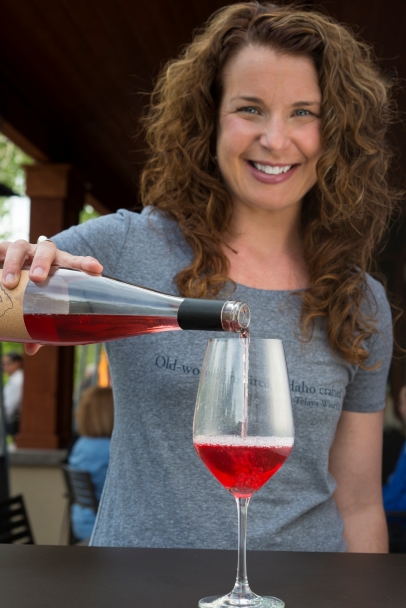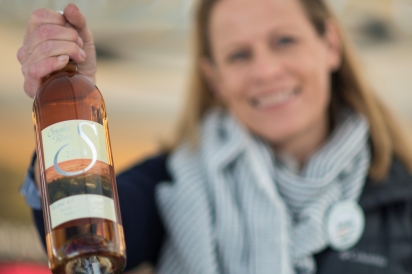THINK PINK Rosé wines are blooming as summer sippers
Pity the poor rosés. Few sommeliers scurry to their cellars to fetch them for eager imbibers. They exist as a hot weather thirst quencher, showing up when the heat rises but are less enthusiastically appreciated than whites such as Sauvignon Blanc, Chardonnay, Riesling and, especially in Idaho, Viognier. So why do some of our best Idaho winemakers and vintners bother to create pink wines?
Imagine you are sitting in a tasting room at the end of a hot day in Sunnyslope or on the shore of Lake Pend Oreille, and you want something refreshing and dry yet unpredictable. This is the moment to try rosé.
Listen to what Idaho’s protean winemaker Greg Koenig said: “I love French-styled rosés; they are absolutely the perfect match for almost all food and there is no better wine to enjoy in the summertime, especially in our dry climate.” Koenig, and Martin Fujishin who works with Koenig and makes his own Fujishin Family Cellars wines, crafted six rosés last year—one for Koenig, and the others for clients including Williamson and Three Horse Ranch. Koenig added, “It is a style of wine that allows us as winemakers to let the vineyard show true without a great deal of intervention.”
What makes a rosé rosé? Grape juice starts out white. The rosy pink color, which can vary from pale amber to strawberry, comes from time exposed to the grape skins. Melanie Krause, whose 2016 Dry Rosé took Double Gold at the 2017 Cascadia Wine Competition, blended Tempranillo and Syrah grapes together. She notes how rosés uniquely make use of the qualities of different grapes. Krause said, “For example, Syrah only takes about an hour to turn the grape juice pink whereas Tempranillo may take five hours and Cinsault may take 12 hours. The color of the grape skins is not directly related to the body or fruitiness of the wine. Syrah makes a very fruity wine with a fair amount of richness in the texture, but so does Cinsault, whereas Tempranillo makes a much more austere rosé, in both flavor and texture.”
Tempranillo is the sole grape in Martin Fujishin’s new T’s Rosé, released on his Lost West Winery brand and named for his fiancée, Teresa, who has been asking him to do a rosé for years.
“We gravitated towards Tempranillo for rosé partly because of when we pick it,” Fujishin said. “It is an early ripening variety, so when you harvest for rosé, it comes in before everything else. Rosé tends to be really technically challenging but with the early pick, we can devote a lot of attention to the fermentation and how it’s shaping up. It gives us time to be much more intentional about our process before the real crush of harvest comes on. By the time the rest of our Tempranillo is rolling in the door for our red wines, the rosé is done fermenting and settling happily in a chilled tank.”
Fujishin, who makes a much-admired Tempranillo, believes rosé is a “great alternative style of wine” that celebrates how well the Spanish stalwart varietal does in Idaho.
Idaho winemakers are using an array of varietals for rosés: Split Rail (Cinsault), Hat Ranch and Koenig (Cabernet Franc), Three Horse Ranch (Grenache and Syrah), Snake River Winery (Mourvèdre), Williamson (Sangiovese), Indian Creek (Syrah and Tempranillo), Talaya and Zhoo Zhoo (Syrah). A wine lover could have great fun tasting the various rosés and guessing their provenance.
Not long ago, the inchoate Idaho wine scene seemed focused on Rieslings (for years the most planted varietal in the state) and Syrahs (which do well in our climate). Some Chardonnay was always planted, then Viognier thrived and became a staple of many Gem State wineries. And Katy bar the door, now Idaho vintners are creating single-varietal wines from grapes that traditionally were used as blenders like Mourvèdre, Cabernet Franc, Petite Sirah and others. Winemakers in the newly created AVA (American Viticultural Area) in and around Lewiston are also seeing fine results from Syrah and Merlot.
Much has changed in the past 15 years in the Idaho wine world. The number of wineries has grown from 11 to more than 50, and there are three AVAs (the third is near Eagle). Our wines are slowly but surely being discovered and the best measure of all: Customers are asking for them at restaurants and in wine shops.
With so much experimentation and excitement surrounding Idaho wine, this season why not try a local rosé—the ultimate summer sipper associated with Provence, Southern France’s beach and lavender-covered hills? After all the state’s largest city has a French name.







